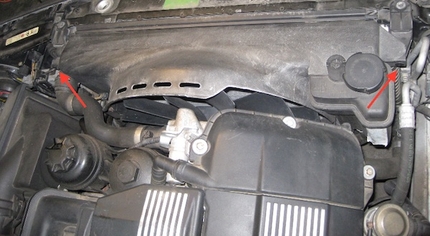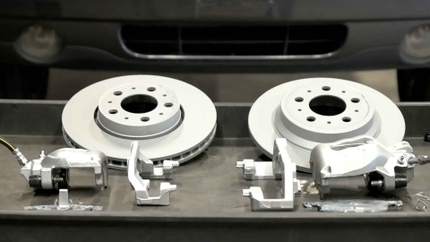When discussing maintenance with other like-minded Volvo enthusiasts, the most common items brought up are engine oil and transmission fluid. What kind of oil should I use? When should I change it? What about transmission fluid? Do I really need the expensive Volvo transmission fluid? How exactly is the fluid changed?
I can't answer all of your questions (I would love to!) - but I'd like to point out one fluid that is often overlooked or forgotten - the power steering fluid! It's a hydraulic fluid that operates at tremendous pressures and often high temperatures, but because it isn't a critical fluid in the drivetrain path like transmission fluid or angle-gear fluid, it's often forgotten or shelved in favor of more pressing maintenance and services. Don't neglect it just because you can't find the service interval in your manual, or because the service writer just shrugs at you when you ask if the power steering fluid has a maintenance schedule. Just like any other fluid system, the power steering system has gaskets and seals that can deteriorate and be damaged by old, improper, or contaminated fluid.
 Many cars actually use a Dexron III ATF or some derivative of it - logical considering that power steering, like a transmission, is also a high pressure and temperature hydraulic system. Volvos and many other European cars, however, usually spec some sort of specific power steering fluid. In my case, the recommended fluid is Pentosin CHF 202. Refer to your owner's manual to determine the correct fluid to use. Pentosin power steering fluid is designed to have a wider operating temperature than ATF - as I discovered accidentally when I brought my Volvo XC90 to a ski trip in Colorado.
Many cars actually use a Dexron III ATF or some derivative of it - logical considering that power steering, like a transmission, is also a high pressure and temperature hydraulic system. Volvos and many other European cars, however, usually spec some sort of specific power steering fluid. In my case, the recommended fluid is Pentosin CHF 202. Refer to your owner's manual to determine the correct fluid to use. Pentosin power steering fluid is designed to have a wider operating temperature than ATF - as I discovered accidentally when I brought my Volvo XC90 to a ski trip in Colorado.
The previous owner of my XC90 had the power steering system serviced and refilled with ATF - this was evident because Pentosin CH F202 is dyed a deep green color, while the fluid in my power steering reservoir was a deep red. On cold mornings in Colorado, the power steering system would protest loudly for a few seconds when the engine was started - a sign that the ATF was unable to perform it's function in the extreme cold environment. Once the system was warmed up, the system worked flawlessly. It was important to note that another XC90 V8 owner was also among our ski party. The power steering fluid in that XC90 was a deep green, and the owner never had issues with noise during a cold start in the same conditions as my car.
When I returned to warm and sunny Houston, it was decided that whatever gunk was substituted into my XC90 had to go, The only tools required to flush out your power steering fluid is some sort of waste container, and a method of removing the hose clamps on the power steering reservoir, The entire procedure takes about an hour of time and can easily be accomplished in the driveway. No special tools are necessary.
If you examine your power steering reservoir, you'll see that the lower hose is the intake sump for the power steering pump. The upper hose is the return - the tank is designed such that any air bubbles in the power steering system will be purged when the fluid is returned to the reservoir.
[gallery columns="2" type="rectangular" ids="2603,2604" orderby="rand"]
All I had to do was clamp off the upper return line, remove it from the reservoir, and redirect it into my waste container. The exposed nipple on the power steering reservoir was plugged with my extremely non-orthodox use of a hex-key socket and a spare bit of hose.
The next part will require two people - one to monitor the power steering fluid reservoir, and one to crank the engine. I found that with the engine started and idling, the power steering pump would draw in fluid from the reservoir quicker than my assistant could pour fresh fluid into the reservoir. While this won't damage anything, it is best to minimize sucking in air to save yourself the trouble of purging the air out later. The best method I found was to remove the ignition fuse from the main relay box, and then crank the engine over to turn the pump and pump the old fluid out. The speed at which the engine cranks is more than enough to cycle out old fluid, and is slow enough that my assistant could keep an eye on the fluid level in the reservoir and keep it topped up with fresh Pentosin.
Be aware that on all XC90 V8 models, the computer has and "auto-crank" feature. Normally when you turn the key to the "START" position, the engine will only crank for as long as you hold the key in "START", and when you release the key back to "II" the engine will stop cranking. On Volvo models equipped with "auto-crank" - as soon as the key turns to "START" - the computer will take over and keep the starter engaged until the engine starts - even if you release the key back to "II" before the engine starts. The engine will continue cranking on it's own until the engine starts, the engine cranks for about 15 seconds with a no-start, or if you turn the key to "OFF".
Like flushing the transmission, keep an eye on the color of the fluid that is expelled into the waste container. When the fluid coming out is a deep green in color, the system is pretty well flushed. Take the key out of the ignition, and re-assemble the power steering reservoir. Remember to top off the power steering tank to the correct "COLD" level as indicated on the dipstick. If you let the reservoir go dry, you might want to overfill it slightly to account for the system purging air when the engine is started.
Clean off your tools and equipment, and start the engine. While the engine is idling, keep an eye on the fluid level and don't let the reservoir go dry. Turn the steering wheel from lock to lock to clear out any remaining air pockets and cycle all of the fresh fluid. Top off again if necessary, and go for a test drive.
Old ATF fluid can be mixed with engine oil and recycled at your local auto parts store or garage.
Since there is no pre-set maintenance schedule on power steering fluid, I usually like to perform a power steering flush with fresh fluid every 50k miles. Keeping fresh, clean fluid in the power steering system is just one step in promoting the life of the seals and gaskets in the expensive power steering pump and steering rack.
How have your experiences been with flushing or changing out power steering fluid?
About the Author: Andrew Peng
 Andrew is an aerospace engineer and car fanatic that enjoys working on his garage of Volvos and Subarus. When he's not busy attending car meets and shows or taking things apart, he enjoys driving his cars and finding interesting new ways to break them. He can be reached via his personal website at http://andrewpeng.net, Facebook, Google+, Instagram, or Twitter.
Andrew is an aerospace engineer and car fanatic that enjoys working on his garage of Volvos and Subarus. When he's not busy attending car meets and shows or taking things apart, he enjoys driving his cars and finding interesting new ways to break them. He can be reached via his personal website at http://andrewpeng.net, Facebook, Google+, Instagram, or Twitter.











